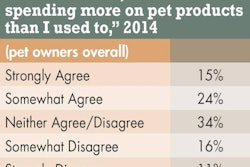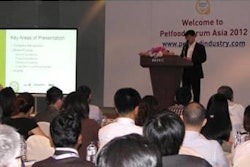Introduction
Energy costs have risen sharply in recent times and most companies have an ongoing strategy aimed at reducing these costs, which are now a significant proportion of manufacturing costs of pet foods. Very few people now dispute the fact of global warming; though there is lively debate about how much of this is a direct result of mankind's activities and further debate about the rate of warming and the effects that will result from this. Many governments are expressing increasing concern about this issue and have different programs to create incentive for individuals and organisations to reduce their energy consumption. As a wider issue the term 'Carbon Footprint' is used to cover the identified total cost of our activities. For a manufacture this brings into play the need to analyse the total 'cost' of manufacturing on a much wider scale than direct energy costs. Retail chains are expressing increasing concern about the Carbon Footprint of products they sell and their own activities, and it is becoming more common for Pet Food Manufacturers to be asked by their customers to state the Carbon Footprint of the products they make. Given the ongoing debate about exactly how to quantify Carbon Footprint and the resulting fragmentation of approach to strategy and methodology it can be very confusing for manufacturers who are trying to address this issue.
The Greenhouse Effect
Carbon Dioxide is recognised as the principal Greenhouse Gas. Without this gas in the atmosphere the earth would be uninhabitable. The presence of just 0.037% of this gas in our atmosphere is responsible for the retention of infra red heat that otherwise would be radiated out into space, leaving the earth as a cold ball of ice floating in space. The balance between the absorption of radiant energy from the sun and the prevention of the release of radiant infra-red energy from the Earth gives us this 'greenhouse' effect, the Earth floating as an island of warmth in the deep cold of space. Note that before the industrial revolution the average atmospheric concentration of carbon dioxide was 0.028%. It is thought that this increase in carbon dioxide as well as other 'greenhouse' gases is creating a situation where an increasing amount of heat is being retained by the Earth, leading to a net warming effect. Unlike our own greenhouses in the garden, where we can open a few windows and ventilate the excess heat away, we are stuck with a closed system.
Carbon Sinks and Sources
So where is all this carbon dioxide gas coming from? Over the millennia the Earth's surface and atmosphere has been gradually cooling down. We are now at our coolest in the last 70 million years, discounting short term fluctuations caused by ice ages. Temperature measurements from the year 1800 to now have shown a trend that suggests increasing temperature, and more recently the rate of temperature change has been shown to match the rate of increasing concentration of greenhouse gases in the upper atmosphere. The Industrial Revolution created a sudden demand for energy and this in turn led to our exploitation of fossil fuel sources such as coal, crude oil and natural gas. The carbon that was locked into these materials was and is released as carbon dioxide gas into the atmosphere. The Earth can substantially buffer this release, a great majority of the released carbon dioxide being reabsorbed by the oceans and vegetation. As the rate of release of carbon dioxide has increased in the last century it is thought that the buffer effect cannot keep up. This is partly because of the effects of deforestation, which has a double negative impact. The carbon tied up as wood in the trees is released by burning and the number of trees and other plants, which absorb carbon dioxide, is reduced. The dynamic balance, then, seems to have shifted. As the temperature increases it is feared that important carbon sinks such as the organic mass of the Arctic tundra will dry out and release its carbon, further exacerbating the situation.
Main Carbon Sinks
- Oceans
- Mineral (Limestone, Chalk)
- Fossil Fuels
- Forests
- Savanna & Arctic Tundra
- Vegetation & Soil
The numbers involved are enormous. Latest figures for carbon emission are for the year 2004, when it was estimated that in the United States 5,988 teragrams (Tg) of carbon dioxide were emitted, with 5,657 Tg of this being from fossil fuel combustion. (Note that 1 teragram is equal to 1,102,311 short tons). This compares with carbon dioxide release in 1990 of 5,005 Tg, an increase of 19.6%. As a comparison to these numbers it was estimated in 2004 that pasture land in the United States sequestered 46 Tg of carbon dioxide. To further illustrate the scale of the numbers involved it is estimated that 1 tonne of wood sequesters 1.035 tonnes of carbon dioxide. As trees grow they tie up or sequester carbon dioxide in the form of wood. It is estimated that, in a tropical rainforest, one tree sequesters about 22 kg (50 pounds) of carbon dioxide per year. Trees in temperate forests grow about three times slower than trees in tropical rainforests, thus sequestering about a third as much carbon dioxide per year. To put the idea of forestation in perspective as a means of offsetting carbon emissions it has been estimated that in the United States and area the size of Texas would have to be planted every thirty years.
There are projects running that are seriously looking at ways of putting carbon dioxide back into the carbon sinks, by pumping it into the seas, used oil and gas wells and by binding it in mineral reserves. These very large scale projects still have obstacles to overcome, however, such as the effect on sea life of increased carbon dioxide levels which will make the seas more acidic.
Gases with Global Warming Potential
The activity of mankind responsible for global warming is referred to as anthropogenic activity. The Kyoto agreement identified six gases that were targeted in terms of reduction of anthropogenic emissions. These are listed below:
The Global Warming Potential (GWP) of
carbon dioxide (CO
2
) is the reference set at an arbitrary value of 1 per 100
years. Note the very high GWP values for hydrofluorocarbons
(HFC's), sulfur hexafluoride (SF
6
) and per-fluoro-chemicals (PFC's).
Also note the high GWP value for Nitrous Oxide (N
2
O). The sources of the halogenated gases are listed
below:
Pet Food Manufacturers will be primarily
concerned with the use of halogenated gases in refrigeration
systems and air conditioning systems. Chlorinated
fluorocarbons (CFC's) are not shown on the above list, which
originates from the European Union. CFC's are particularly
active in that they rise to the upper layers of the
atmosphere where they are broken down by Ultra Violet Light
to release chlorine, which breaks down the ozone layer. The
use of CFC's has been banned in Europe and the sale of
R-12 Freon, a commonly used CFC, has been banned in the USA. HFC's are not as harmful as CFC's in that they are broken down more easily and largely do not rise to the upper atmosphere. For this reason companies round the world are working to replace CFC's with HFC's. There are even more environmentally friendly refrigerant gases such as ammonia and carbon dioxide, which are increasingly used in 'Eco-Friendly' systems designed to handle these materials.
Most of the methane released by man-made activities is from Agricultural Production, from Sewage Processing and from Land Fills.
Nitrous Oxide is emitted by bacteria in the soil and in the oceans, from combustion of fossil fuels and from manure and human sewage. Agricultural activities are said to cause the release of about 2-4 million tonnes of the gas annually, or about 67% of the total released by anthropogenic activities. The nitrogen in agriculture comes from both application of animal manure and nitrogenous fertilisers. There is an argument that nitrogenous fertilisers leach more easily into water courses, especially when used at too high a rate. This results in increased bacterial activity in these watercourses and estuarine areas, creating increased nitrous oxide release. In automobiles, responsible for about 11% of the gas, catalytic converters can actually promote the release of nitrous oxide. There are recent technical modifications to catalytic converters that are addressing this problem. Like the halogenated gases nitrous oxide attacks ozone in the upper atmosphere. It has a high Global Warming Potential compared to carbon dioxide because of its persistence in the atmosphere after release.
Carbon Offsets and Alternative Energy Sources
There are schemes that have been established by various governments and organisations that allow industries to offset their carbon emissions. This is achieved by investing in an accredited scheme to buy carbon credits. Theoretically an organisation can pay for the carbon they emit, or partially offset the amount of carbon they emit, by investing in a scheme that reduces carbon emissions. There is an issue proving the credibility of some offset providers and further problems in verifying many types of offset in terms of measurable reduction in carbon emissions. The range of investment in offset schemes varies from US$1-30 per tonne of carbon dioxide.
Carbon Offset Projects
- Renewable Energy
- Energy Efficiency
- Methane Capture
- Forestry
There is ongoing debate about the effectiveness of measures taken to offset carbon emissions. For example, it is stated with some conviction by several influential bodies that the manufacture of some types of biofuel cause an increase in environmental damage and create social problems. These projects tend to be global in concept and most pet food manufacturers would not be directly involved in them, other than financial investment to buy carbon credits.
Analysing Carbon Footprint
Before looking at the possibility of any investment in either direct changes within the company or investment in carbon offset projects a company needs to establish its overall carbon footprint.
It is possible to calculate the total carbon footprint for an organisation relatively easily using one of the many calculator packages available on the internet. The following information will need to be prepared in advance to carry out the calculation:
1. Number of Staff and Sites
2. Annual Fuel consumption (natural gas, propane, oil etc) in kilowatt hours
3. Amount of waste disposed to landfill and/or incinerated
4. Annual distance or fuel consumption of company owned vehicles, including
gasoline, diesel, hybrid, LPG, electric, hydrogen
5. Annual business travel distance or fuel consumption of company vehicles
6. Annual business journeys taken by taxi or train
7. Annual number of short/long haul flights
8. Annual number of nights stay in hotels
9. Annual commuting distances by staff - cars, motorcycles, public transport
Having gained a picture of the overall position the operation needs to be broken down into manageable parts so that action plans can be formulated and implemented. The following diagram may help during this phase of the project.
There are abundant resources available on the internet to help with the analysis. In different regions there are also various sources of assistance expressed as advice and financial incentives. These latter resources should be fully explored before embarking on the project.
Implementation
As a commercial organisation the risks and benefits of adopting a low carbon agenda will have been analysed by the organisation. An overview is needed of the genuine cost efficincy benefits and the positive impacts on sales, reputaion, trust and long term sustainability. As an integral part of the implementation strategy there should be a strategy in place that presents clear and upfront information to customers and consumers through labelling, advertising and personal communication. Achievable targets should be established to reduce carbon footprint that give measurable objectives in terms of energy savings, compliance with targets, whether they be government or customer imposed, and consumer awareness strategies.
The implementation chart gives a broad overview of some of the measures that can be taken to reduce energy consumption and reduce carbon footprint. The biggest energy user in the company is the manufacturing plant, and it is here that the biggest savings can be quickly made, not always with the need for high capital investment.
The use of process flow diagrams can assist with analysis and planning. Start by writing out list of questions
1. What is the 'no-load' power draw on all the motors?
2. Are motors run for long periods with no product running? - Why?
3. Which motors would benefit from the use of Inverters?
4. What is theoretical use of steam in conditioner compared to actual?
5. Do we pre-heat conditioning water?
6. What benefit would pre-hydration of dry feed give us?
7. What are air-flows, temperatures and humidities?
8. Can we re-use process air?
9. Is the dryer optimised?
10. Are production rates maximised?
11. How much start-up and shut-down waste? - Why?
12. How is waste handled? - Why?
13. Are we over-drying product?
14. Can we handle ingredients in re-useable containers - not disposable bags?
15. Are we using extruder cooling water as boiler make-up water?
16. Do we know exact energy cost for each product?
17. Do we know SME and STE balance for each product?
Conclusion
It is a matter of common sense commercial management to understand energy use and material wastage, so whether or not we agree with any or all of the issues related to Global Warming it can only do our companies good to adopt a culture of minimised energy and waste. An opportunity is created to demonstrate to our customers and regulatory authorities that our companies continue to follow practices of sustainability and ethical manufacture and are empathic with public perceptions and changing global issues.
.png?auto=format%2Ccompress&crop=faces&fit=crop&h=48&q=70&w=48)

















